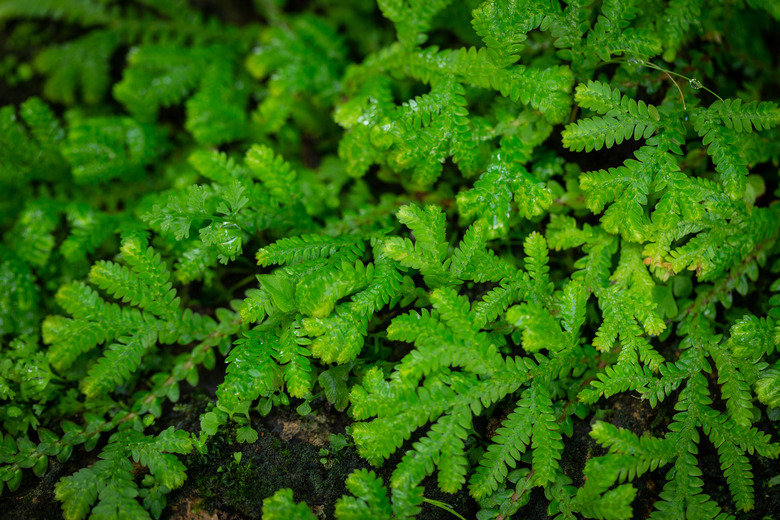The Life Cycle Of Selaginella
Spike mosses, or selaginella plants, are very interesting herbs and one of the largest genera of land plants. The fossil record suggests that plants in the genus Selaginella have existed for many epochs. Selaginella plants have a fascinating life cycle that is quite different from that of flowering plants.
TL;DR (Too Long; Didn't Read)
The selaginella plant, or spike moss, is a non-flowering plant with a unique life cycle that uses microspores and megaspores to reproduce. It requires water for this process to take place.
What Is the Selaginella Plant?
What Is the Selaginella Plant?
Selaginella is a spike moss. Selaginella plans are lycophytes, which is a group of vascular plants that are considered "fern allies." Another name for selaginella is the 'resurrection plant.' It gains this nickname from its ability to rejuvenate after being dehydrated, particularly in desert varieties like Selaginella lepidophylla.
Selaginella plant species number over 700 throughout the world. This resilient, adaptive plant possesses a number of interesting features.
Characteristics of Selaginella
Characteristics of Selaginella
Selaginella, or spike moss plants, have flattened shoots and leaves in four rows. Their structure is reminiscent of a fern's. The outer stems of the selaginella curls around the younger stems of the center of the plant. This protects the plant against too much sunlight damage or from drying out.
Selaginella plants possess sporophylls and sporangia in clusters of strobili at the tips of their branches. These sporophylls are largely consistent in size and shape across species. Many spike mosses have matted yet delicate roots. They are delicate and free-sporing plants that do not produce flowers.
Selaginella plants have existed for many millions of years, with some species likely dating as far back as the Carboniferous or Devonian times. Some fossils of selaginella plants were found in amber.
Many species of selaginella dwell in moist environments such as tropical forests. However, a number of spike mosses also thrive in drier areas. One example is the lesser spikemoss, Selaginella densa, which can be found in prairies and in montane ecosystems. Spike mosses are not valuable grazing plants for large animals in those colder environments, but some elk, mule deer and waterfowl consume them.
Life Cycle of Selaginella
Life Cycle of Selaginella
The life cycle of selaginella is quite interesting, both similar yet distinct from that of flowering plants or angiosperms. Selaginella does have heterospory and sex allocation in its sporophyte generation. However, it does not have the protective, maternal features that occur after fertilization in angiosperms. There are no fruits or seeds. Fruit and seed development is considered a female-biased sex allocation.
In selaginella, microspores and megaspores are instead produced by the paternal and maternal parts of the plant. The spore-bearing parts of selaginella are called microsporangia and megasporangia. The megasporangia can be found under the microsporangia.
Microspores fall passively to the ground through cones called strobili. The sporophyte of selaginella releases and disperses those spores once they mature. They possess tiny, flagellated sperm that need water to swim to egg cells. The egg cells are produced by the megasporangia. Water therefore plays an essential role in the life cycle of selaginella, and in drought, it might be hard to find young plants.
Mating and game production do not happen near the parent. Selaginella is considered to have a male-biased sex allocation, with the microsporangia being far more abundant than megasporangia. However, there are a few species of selaginella that do have more megasporangia. As a selaginella plant grows older, its center dies and leaves living material around that center.
The Importance of Selaginella in the Environment
The Importance of Selaginella in the Environment
Studying selaginella provides valuable information on how the plant fits into ecosystems, and how it helps the environment. Selaginella develops mats on slopes, and aids with erosion prevention. If their roots are not disturbed, spike mosses can persevere well through droughts.
They are colloquially called 'resurrection plants,' and the selaginella plants can handle various environmental challenges and return to their former lush quality with rehydration. This is due to its protective curling, with outer, more mature leaves and stems spiraling around the younger interior, behaving as a protective barrier to the elements. When rain is abundant, this coiled package opens again.
Additionally, selaginella plants are cushiony and can handle trampling reasonably well. This makes them popular in gardens. Selaginella uses its matting qualities and its shallow, delicate roots to absorb surrounding water. The mats of the selaginella help to filter water runoff.
Cite This Article
MLA
Hermance, Dianne. "The Life Cycle Of Selaginella" sciencing.com, https://www.sciencing.com/the-life-cycle-of-selaginella-13404816/. 20 October 2021.
APA
Hermance, Dianne. (2021, October 20). The Life Cycle Of Selaginella. sciencing.com. Retrieved from https://www.sciencing.com/the-life-cycle-of-selaginella-13404816/
Chicago
Hermance, Dianne. The Life Cycle Of Selaginella last modified March 24, 2022. https://www.sciencing.com/the-life-cycle-of-selaginella-13404816/
